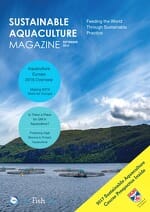The Biomass Daily is a unique system, designed by Vaki, for measuring the size/biomass of fish swimming in a sea cage, allowing the growth patterns of fish to be followed and for feed efficiency to be monitored.
As fish swim through a submerged 80 x 80 cm wide frame structure infrared technology precisely measures the fish’s length, depth and width. “As the fish swim through the frame it breaks the infrared beam and measures the size of the fish,” Mr Hálfdanarson explained.
The frame is usually placed into the cage when smolts are transferred and remains there till harvesting.
Vaki, which is celebrating its 30th anniversary this year, originally started using the infrared technology back in 1986 in its first smolt counter – the Bioscanner.
After the initial fish counter there was interest in creating something similar that could measure the size of fish, explained Mr Hálfdanarson.
Exploiting the capability of infrared technology to penetrate water well, thirty years on the company has advanced its original technology to produce the Biomass Daily.
There were challenges along the way, revealed Mr Hálfdanarson.
The original frame was smaller in size (50 x 50 cm) than it is today and fish did not swim through as often, especially in low density cages.
However, now the frame is bigger that is no longer a problem, Mr Hálfdanarson confirmed.
On average, in a typical salmon cage with a density of around 15 kg/m3, around 5,000 fish swim through the frame each day giving an impressive sample size, which delivers an accurate and reliable average biomass reading.
Accurate Estimations
In order to get an accurate estimation the frame should be hung at a depth in the cage where the highest density of fish occur in the fishes’ swimming pattern.
“This may or may not change,” said Mr Hálfdanarson. “But farmers should keep an eye on their fish so that the frame is always in the best possible position.”
The frame itself is submerged into the cage 2-3m from the edge and data is transferred from the frame to a sending box fixed outside of the cage. Information is then sent from the box to a computer and cloud based system where it can be accessed remotely on a phone or tablet, providing real-time data.
Whilst the frame can measure the size of any fish, the technology works best with salmonids and fish that have homogenous growth, circular swimming patterns and the higher density the better. This is because it provides a bigger sample number as more fish are likely to swim through, said Mr Hálfdanarson.
“The Biomass Daily technology is very easy to implement,” Mr Hálfdanarson assured. “All you need is an electricity source and an internet connection. At night, a re-chargeable battery can be used if there is no power.
The Biomass Daily is currently in use on salmon farms in all of the world’s leading salmon farming countries, with all major salmon farming companies on the customer list.
The system is however currently being trialed with other species such as sea bass, sea bream and tilapia.
Delivering Benefits to the Fish and Farmer
By giving an accurate estimation of fish size, the Biomass Daily offers the farmer the capability to optimise production and detect changes in growth as soon as they occur.
“Through monitoring the size of your fish daily, you are able to identify problems with feeding or signs of ill health,” said Mr Hálfdanarson.
“If fish appear to be eating but not growing this could give an early warning of a disease issue.”
Similarly, daily measurements help show the correlation between feed and growth, giving a better idea of the Feed Conversion Ratio (FCR) and when too much feed is being used. Thus saving you money.
Many farms have one frame fixed permanently in each cage. This gives the farmer the ability to compare and collaborate important information within or even between sites.
Farmers can then see if fish fed the same amount are growing differently between sites or if certain diets lead to better growth, for example.
Knowing the size of your fish each day also helps the farmer better plan when to harvest or grade.
“Having reliable information means you can calculate the size of the fish at harvesting more accurately when preselling, meaning you can get the best price for your fish.”
Another benefit of installing the system on your farm is that it can help recover costs from insurance companies as, if a claim is made, they will be more likely to pay out the correct amount if you can show exactly what size your fish were, said Mr Hálfdanarson.
Using Biomass Daily is also better for the welfare of the fish as they no longer need to be crowded, netted and weighed by hand, which stresses the fish and sometimes even leads to mortality.
This old method of sampling is labour intensive and, due to the loss of profit from fish deaths, farmers often only sample around 100 fish per cage. Such a small sample size and infrequent sampling does not give an accurate picture, explained Mr Hálfdanarson.
The Biomass Daily is therefore cost effective to use and, overall, it is a useful tool in strategic production, especially where maximum allowed biomass rulings apply, Mr Hálfdanarson concluded.
For more information on the Biomass Daily, please go to http://www.vaki.is/products/biomass-daily
 This article was taken from the September 2016 Sustainable Aquaculture Magazine.
This article was taken from the September 2016 Sustainable Aquaculture Magazine.




